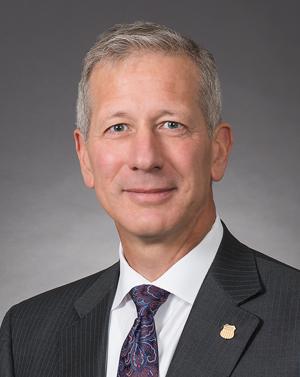UP now has about 90 contractors working on the yard, down from 300. Crews were aiming to open the yard as early as December, UP officials said last year, but now the railroad does not have an opening date scheduled.
“We have slowed the pace a little bit, but we continue to work on things like grading and drainage and trackwork,” UP spokeswoman Kristen South told Texas radio station WTAW last week.
UP is reviewing how to use the yard and how it will best fit into the system under its new operating plan, which UP launched in October, about eight months after construction began.
“Right now, we are evaluating what our customers need and how this yard plays into our overall system,” South says.
Last month, CEO Lance Fritz told an investor conference that Brazos would remain important to UP but that it would use the yard differently than originally envisioned.
“We continue to evaluate exactly how are we going to use it,” Fritz said. “We had a game plan when we first designed it and started the build. It still looks like a valuable asset so there’s no reason to think that it’s not. But it’s going to be used differently than the original design.”
It was unclear if that meant the yard would ultimately become a flat-switching facility where through trains would swap blocks. The yard is being built at the strategic junction of seven UP routes.
It was not immediately clear if the slowdown in Brazos construction — which would curtail spending at the site — was related to an expected shuffling of UP’s capital budget.
UP Chief Operating Officer Jim Vena said in January that the railroad this year aims to quickly begin running longer trains in single-track territory and that it was identifying where to build longer passing sidings.
Executives said they would fund the siding extensions by shifting money around in this year’s $3.2-billion capital budget.
Running longer trains — which reduces train starts and locomotive and crew requirements — is a key element of the Precision Scheduled Railroading operating model UP began implementing in October.
The Unified Plan 2020, based on the late E. Hunter Harrison’s principles of Precision Scheduled Railroading, also calls for a reduced emphasis on major terminals as cars are pre-blocked at origin and sent further into the network before being switched.















Right. The railroads are paranoid over Wall Street. Basically. The railroads are telling the shipping community, here is our schedule, we are making money as is, take it or leave it. As shippers leave, the railroads will continue to shrink relative to the overall size of the market. The battle of market share vs trucking is over. It is just a battle how much the railroads can pocket before that last single 4 mile train can be run with 12 locomotives once a day in each direction. Average speed, 25 mph. That is the industry’s blue print for the future. Unbelievable that the railroads perceive themselves as common carriers these days.
“Based on the principles of E. Hunter Harrison’s Precision Scheduled Railroading”.
Hey, that’s a double shot!
PSR is just another term for laying out an orderly going-out-of-business strategy.
Longer trains mean longer dwell times to build a train and ultimately deliver poorer customer service. The railroads are looking at PSR through rose colored glasses. Meantime our highways are bulging with trucks. Great work railroads.
Possibly similar for Proviso.
Not crazy to imagine having North Platte, Hearne, and maybe Neff create ALL the necessary Chicago, Memphis and St Louis carload blocks, interchange and “local hauler” alike. Just like Hinkle, North Platte, Hearne, Roseville and maybe Neff could do for SoCal. Hmmmm maybe they don’t need Red Rock after all.
Then significantly expand decently located Global 2, close cramped and inefficient Global 1 and Yard Center, and run all the intermodals to either Global 2 or Global 4. Steel wheel interchange no less efficient from Global 2, and rubber tire interchange to some key interchange partners at least no worse on the Tri State Tollway from there to Bedford Park, Homewood, Landers. CP’s ramp is next door. CSX 71st and NS 47th or Manor Park are badly located for today’s IM needs (except for rubber tire from Corwith or Cicero or Global 1 over the Chicago streets) and they need their own better regional solution…
Here’s what I think. Apart from BNSF, the Canadians and now CSX the Class 1s really do have too many older expensive to maintain hump yards for the current or even a significantly grown “loose car” carload freight network.
But if you look at the UP example, locating the fewer but still needed automated high throughput classification terminals away from expensive metropolitan real estate makes all kinds of sense. So new modern humps at Hearne or Red Rock, AZ, and preserving/upgrading existing ones at Hinkle, OR or even Roseville make sense as major terminal locations. But they closed Hinkle’s hump and are rumored to be downgrading Roseville.
All of which add to car counts at Davidson (Ft Worth), Englewood (Houston), Albina, OR (Portland, not a hump yard) and the poster child for bad decisions: West Colton. ALL of which are or should be converted to greatly expanded intermodal ramp capacity if they were serious about capturing growth in that business. Which I guess Big Finance is telling them they shouldn’t be.
Another PSR stranded investment. Class 1’s are littered with this dis-investment in physical plant. Shrink-mode lives! Executives, Wall Street and hedgies love it!
What is more stupid? 1) To have an operating hump yard or 2) have a non operating hump yard with wasted resources.